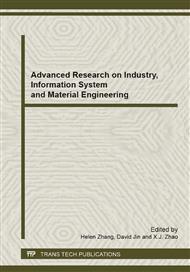[1]
M.F. Rahman, J. Wang, T.A. Patterson, et al. Expression of genes related to oxidative stress in the mouse brain after exposure to silver-25 nanoparticles Original Research. Toxicology Letters, 2009, 187(1): 15-21.
DOI: 10.1016/j.toxlet.2009.01.020
Google Scholar
[2]
Shuchun Li, Haitao Wang, Yuhua Qi, et al. Assessment of nanomaterial cytotoxicity with SOLiD sequencing-based microRNA expression profiling. Biomaterials, 2011, 32: 9021-9030.
DOI: 10.1016/j.biomaterials.2011.08.033
Google Scholar
[3]
Fenart L, Casanova A, Dehouck B, , et al. Evaluation of effect of charge and lipid coating on ability of 60nm nanoparticles to cross an in vitro model of the blood-brain barrier. J Pharmacol Exp Ther, 1999, 291(3): 1017~1022.
Google Scholar
[4]
Lockman PR, Oyewumi MO, Koziara JM, , et al. Brain uptake of thiamine coated nanoparticles. J Control Release, 2003, 93: 271~282.
DOI: 10.1016/j.jconrel.2003.08.006
Google Scholar
[5]
Dobrovolskaia MA, Mcneil SE. Immunological properties of engineered nanomaterials. Nat Nanotechnol, 2007, 2: 469~478.
Google Scholar
[6]
Byrne JD, Betancourt T, Brannon-Peppas L. Active targeting schemes for nanoparticle systems in cancer therapeutics. Adv Drug Deliv Rev, 2008, 60: 1615~1626.
DOI: 10.1016/j.addr.2008.08.005
Google Scholar
[7]
Huang XL, Teng X, Chen D, Tang F, He J. The effect of the shape of mesoporous silica nanoparticles on cellular uptake and cell function. Biomaterials, 2010, 31: 438~448.
DOI: 10.1016/j.biomaterials.2009.09.060
Google Scholar
[8]
Pisanic II TR, Blackwell JD, Shubayev VI, et al. Nanotoxicity of iron oxide nanoparticle internalization in growing neurons. Biomaterials, 2007, 28: 2572~2581.
DOI: 10.1016/j.biomaterials.2007.01.043
Google Scholar
[9]
Stern ST, Zolnik BS, McLeland CB, et al. Induction of autophagy in porcine kidney cells by quantum dots: A common cellular response to nanomaterials? Toxicol Sci, 2008, 106(1): 140~152.
DOI: 10.1093/toxsci/kfn137
Google Scholar
[10]
Seleverstov O, Zabirnyk O, Zscharnack M, et al. Quantum dots for human mesenchymal stem cells labeling. A size-dependent autophagy activation. Nano Lett, 2006, 6: 2826~2832.
DOI: 10.1021/nl0619711
Google Scholar


